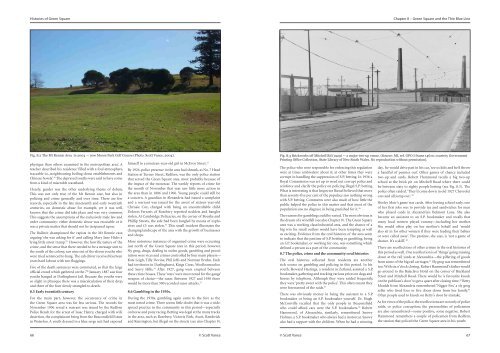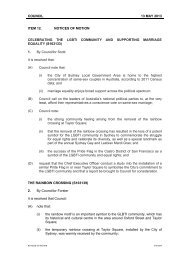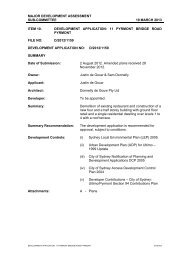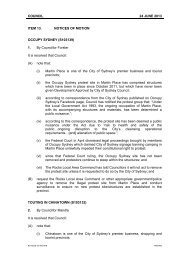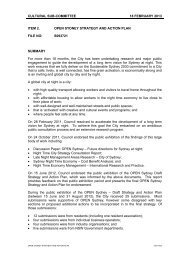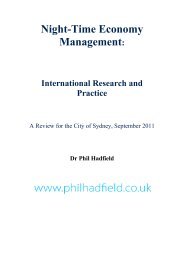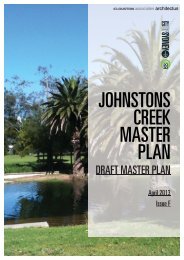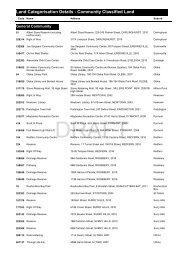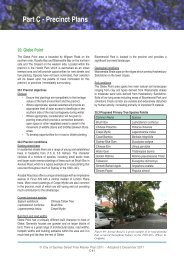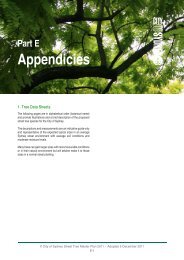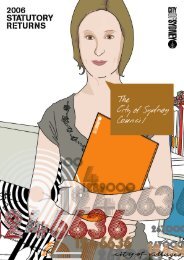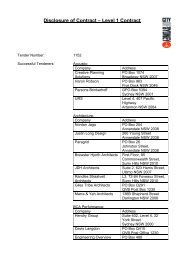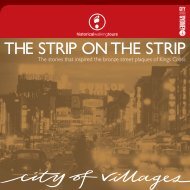Histories of Green Square - City of Sydney
Histories of Green Square - City of Sydney
Histories of Green Square - City of Sydney
Create successful ePaper yourself
Turn your PDF publications into a flip-book with our unique Google optimized e-Paper software.
<strong>Histories</strong> <strong>of</strong> <strong>Green</strong> <strong>Square</strong><br />
Fig. 8.2 The Mt Rennie Area in 2004 — now Moore Park Golf Course (Photo: Scott Vance, 2004).<br />
physique than others examined in the metropolitan area’. A<br />
teacher described his residence ‘filled with a foul atmosphere,<br />
traceable to...neighbouring boiling down establishments and<br />
Chinese hovels’. 30 The depraved youths were said to have come<br />
from a kind <strong>of</strong> miserable wasteland.<br />
Clearly, gender was the other underlying theme <strong>of</strong> debate.<br />
This was not only true <strong>of</strong> the Mt Rennie case, but also in<br />
policing and crime generally and over time. There are few<br />
records, especially in the late nineteenth and early twentieth<br />
centuries, on domestic abuse for example, yet it was wellknown<br />
that the crime did take place and was very common.<br />
This suggests the assumptions <strong>of</strong> the exclusively male law and<br />
order community: either domestic abuse was excusable or it<br />
was a private matter that should not be trespassed upon.<br />
The Bulletin championed the rapists in the Mt Rennie case,<br />
arguing ‘she was asking for it’ and calling Mary Jane Hicks a<br />
‘lying little street tramp’. 31 However, the horrific nature <strong>of</strong> the<br />
crime, and the sense that there needed to be a message sent to<br />
the youth <strong>of</strong> the colony, saw nine out <strong>of</strong> the eleven youths who<br />
were tried sentenced to hang. The cab driver received fourteen<br />
years hard labour with two floggings.<br />
Five <strong>of</strong> the death sentences were commuted, so that the large<br />
<strong>of</strong>ficial crowd which gathered on the 7 th January 1887 saw four<br />
youths hanged at Darlinghurst Jail. Because the youths were<br />
so slight in physique there was a miscalculation <strong>of</strong> their drop,<br />
and three <strong>of</strong> the four slowly strangled to death.<br />
8.5 Early twentieth century<br />
For the main part, however, the occurrence <strong>of</strong> crime in<br />
the <strong>Green</strong> <strong>Square</strong> area was far less serious. The records for<br />
November 1906 reveal a warrant was issued by the Redfern<br />
Police Bench for the arrest <strong>of</strong> Isaac Henry, charged with wife<br />
desertion, the complainant being from the Beaconsfield Estate<br />
in Waterloo. A youth dressed in a blue serge suit had exposed<br />
66<br />
himself to a nineteen-year-old girl in McEvoy Street. 32<br />
By 1926, police presence in the area had shrunk, as No. 7 Head<br />
Station at Turner Street, Redfern, was the only police station<br />
that served the <strong>Green</strong> <strong>Square</strong> area, most probably because <strong>of</strong><br />
the impact <strong>of</strong> the motorcar. The weekly reports <strong>of</strong> crime for<br />
the month <strong>of</strong> November that year saw little more action in<br />
the area than in 1886 and 1906. Young people could still be<br />
a concern. A guardian in Alexandria had issued a complaint<br />
and a warrant was issued for the arrest <strong>of</strong> sixteen-year-old<br />
Chrissie Cox, charged with being an uncontrollable child.<br />
Dolores Ferraris <strong>of</strong> Rosebery reported necklets and bangles<br />
stolen. At Cambridge Delicacies, on the corner <strong>of</strong> Bourke and<br />
Phillip Streets, the safe had been burgled by means <strong>of</strong> explosives<br />
and £5 was stolen. 33 This small incident illustrates the<br />
changing landscape <strong>of</strong> the area with the growth <strong>of</strong> businesses<br />
and shops.<br />
More notorious instances <strong>of</strong> organised crime were occurring<br />
just north <strong>of</strong> the <strong>Green</strong> <strong>Square</strong> area in this period, however.<br />
Sly grog, drugs, dealing in stolen goods, gambling and prostitution<br />
were vices and crimes controlled by four main players—<br />
Kate Leigh, Tilly Devine, Phil Jeffs and Norman Bruhn. Each<br />
had territories in Darlinghurst, Kings Cross, Woolloomooloo<br />
and Surry Hills. 34 After 1927, gang wars erupted between<br />
these crime bosses. These ‘wars’ were most noted for the gangs’<br />
weapon <strong>of</strong> choice—the razor. Between 1927 and 1930 there<br />
would be more than 500 recorded razor attacks. 35<br />
8.6 Gambling in the 1930s.<br />
During the 1930s, gambling again came to the fore as the<br />
most noted crime. There seems little doubt that it was a widespread<br />
practice in the community in this period—especially<br />
on horse and pony racing. Betting was legal at the many tracks<br />
in the area, such as Rosebery, Victoria Park, Ascot, Randwick<br />
and Kensington, but illegal on the streets (see also Chapter 9).<br />
© Scott Vance<br />
The police who were responsible for enforcing this regulation<br />
were at times ambivalent about it; at other times they were<br />
corrupt in handling the suppression <strong>of</strong> S.P. betting. In 1936 a<br />
Royal Commission was set up to weed out corrupt police and<br />
reinforce and clarify the policy on policing illegal S.P. betting.<br />
What is interesting is that Inspector Russel believed that more<br />
than seventy-five per cent <strong>of</strong> the populace saw nothing wrong<br />
with S.P. betting. Comments were also made <strong>of</strong> how little the<br />
public helped the police in this matter and that most <strong>of</strong> the<br />
population saw no disgrace in being punished for it. 36<br />
The reasons for gambling could be varied. The most obvious is<br />
the dream <strong>of</strong> a windfall (see also Chapter 9). The <strong>Green</strong> <strong>Square</strong><br />
area was a working class/industrial area, and the chance <strong>of</strong> a<br />
big win for small outlays would have been tempting as well<br />
as exciting. Evidence from the oral histories <strong>of</strong> the area seem<br />
to indicate that the pastime <strong>of</strong> S.P. betting or gambling, being<br />
an S.P. bookmaker, or working for one, was something which<br />
defined a person as a part <strong>of</strong> the community.<br />
8.7 The police, crime and the community: oral histories<br />
The oral histories collected from residents are another<br />
rich source on gambling and policing in this period. In his<br />
youth, Howard Hastings, a resident in Zetland, assisted a S.P.<br />
bookmaker, gathering and tracking various prices on dogs and<br />
horses by telephone. Although they were raided frequently,<br />
they were ‘pretty sweet with the police’. This <strong>of</strong>ten meant they<br />
were forewarned <strong>of</strong> the raids. 37<br />
There was obviously money in being the assistant to a S.P.<br />
bookmaker or being an S.P. bookmaker yourself. Dr. Hugh<br />
McConville recalled that the only people in Beaconsfield<br />
who could afford cars were the S.P. bookmakers. 38 Robert<br />
Hammond, <strong>of</strong> Alexandria, similarly, remembered Snowy<br />
Holmes, a S.P. bookmaker who always had a motorcar. Snowy<br />
also had a rapport with the children. When he had a winning<br />
© Scott Vance<br />
Chapter 8 – <strong>Green</strong> <strong>Square</strong> and the Thin Blue Line<br />
Fig. 8.3 Brickworks <strong>of</strong>f Mitchell Rd (1929) — a major two-up venue. (Source: ML ref. GPO I frame 14610, courtesy Government<br />
Printing Office Collection, State Library <strong>of</strong> New South Wales. No reproduction without permission).<br />
day, he would drive past in his car, ‘see us kids and he’d throw<br />
a handful <strong>of</strong> pennies out’. Other games <strong>of</strong> chance included<br />
two-up and cards. Robert Hammond recalls a big two-up<br />
school at the brick pit on Mitchell Road where there could<br />
be between sixty to eighty people betting (see Fig. 8.3). The<br />
police <strong>of</strong>ten raided. ‘They’d come down in old 1927 Chevrolet<br />
cars and all jump out’. 39<br />
Shirley Moir’s game was cards. After leaving school early, one<br />
<strong>of</strong> her first jobs was to provide tea and sandwiches for men<br />
who played cards in Alexandria’s Belmont Lane. She also<br />
became an assistant to an S.P. bookmaker and recalls that<br />
many local women played rummy—including her mother.<br />
She would <strong>of</strong>ten play on her mother’s behalf and ‘would<br />
also sit in for other women if they were feeding their babies<br />
or were called away’. The pastime, she says, is ‘not a game <strong>of</strong><br />
chance. It’s a skill’. 40<br />
There are recollections <strong>of</strong> other crimes in the oral histories <strong>of</strong><br />
this period as well. One recollection is <strong>of</strong> ‘things’ going missing<br />
down at the rail yards at Alexandria—the pilfering <strong>of</strong> goods<br />
from some <strong>of</strong> the big rail carriages. 41 Sly grog was remembered<br />
too. With six o’clock closing, Robert Hammond’s father would<br />
go around to the Balaclava Hotel on the corner <strong>of</strong> Buckland<br />
Street and Mitchell Road. There would be ‘a favourite knock<br />
on the publican’s door’ to get a quart after closing time. 42 Betty<br />
Moulds from Alexandria remembered ‘Nigger Fox’ a sly grog<br />
seller who lived four or five doors down from her family. 43<br />
Often people used to knock on Betty’s door by mistake.<br />
As for views <strong>of</strong> the police, the recollections are not only <strong>of</strong> police<br />
raids, or police corruption; the personalities <strong>of</strong> policemen<br />
are also remembered—some positive, some negative. Robert<br />
Hammond remembers a couple <strong>of</strong> policemen from Redfern,<br />
the station that policed the <strong>Green</strong> <strong>Square</strong> area in his youth:<br />
67


